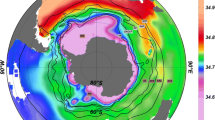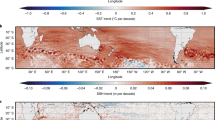Abstract
The existence in the ocean of deep western boundary currents, which connect the high-latitude regions where deep water is formed with upwelling regions as part of the global ocean circulation, was postulated more than 40 years ago1. These ocean currents have been found adjacent to the continental slopes of all ocean basins, and have core depths between 1,500 and 4,000 m. In the Atlantic Ocean, the deep western boundary current is estimated to carry (10–40) × 106 m3 s-1 of water2,3,4,5, transporting North Atlantic Deep Water—from the overflow regions between Greenland and Scotland and from the Labrador Sea—into the South Atlantic and the Antarctic circumpolar current. Here we present direct velocity and water mass observations obtained in the period 2000 to 2003, as well as results from a numerical ocean circulation model, showing that the Atlantic deep western boundary current breaks up at 8° S. Southward of this latitude, the transport of North Atlantic Deep Water into the South Atlantic Ocean is accomplished by migrating eddies, rather than by a continuous flow. Our model simulation indicates that the deep western boundary current breaks up into eddies at the present intensity of meridional overturning circulation. For weaker overturning, continuation as a stable, laminar boundary flow seems possible.



Similar content being viewed by others
References
Stommel, H. & Arons, A. B. On the abyssal circulation of the World Ocean—I. Stationary planetary flow patterns on a sphere. Deep-Sea Res. 6, 140–154 (1960)
Lee, T. N., Johns, W. E., Zantopp, R. J. & Fillenbaum, E. R. Moored observations of western boundary current variability and circulation at 26.5° N in the subtropical North Atlantic. J. Phys. Oceanogr. 26, 962–983 (1996)
Schott, F. A. et al. Circulation and deep-water export at the western exit of the subpolar North Atlantic. J. Phys. Oceanogr. 34, 817–843 (2004)
Johns, W. E., Fratantoni, D. M. & Zantopp, R. J. Deep western boundary current variability off northeastern Brazil. Deep-Sea Res. I 40, 293–310 (1993)
Fischer, J. & Schott, F. A. Seasonal transport variability of the Deep Western Boundary Current in the equatorial Atlantic. J. Geophys. Res. 102, 27751–27769 (1997)
Ganachaud, A. & Wunsch, C. Improved estimates of global ocean circulation, heat transport and mixing from hydrographic data. Nature 408, 453–457 (2000)
Lumpkin, R. & Speer, K. Large-scale vertical and horizontal circulation in the North Atlantic Ocean. J. Phys. Oceanogr. 33, 1902–1920 (2003)
McCartney, M. S. Recirculation components to the deep boundary current of the northern North Atlantic. Prog. Oceanogr. 29, 283–383 (1992)
Hogg, N. G. On the transport of the Gulf Stream between Cape Hatteras and the Grand Banks. Deep-Sea Res. I 39, 1231–1246 (1992)
Lozier, M. S. Evidence for large-scale eddy-driven gyres in the North Atlantic. Science 277, 361–364 (1997)
Edwards, C. A. & Pedlosky, J. Dynamics of nonlinear cross-equatorial flow. Part I: Potential vorticity transformation. J. Phys. Oceanogr. 28, 2382–2406 (1998)
Richardson, P. L. & Fratantoni, D. M. Float trajectories in the deep western boundary current and deep equatorial jets of the tropical Atlantic. Deep-Sea Res. II 46, 305–333 (1999)
Lux, M., Mercier, H. & Arhan, M. Interhemispheric exchanges of mass and heat in the Atlantic Ocean in January-March 1993. Deep-Sea Res. I 48, 605–638 (2001)
Schott, F. A., Brandt, P., Hamann, M., Fischer, J. & Stramma, L. On the boundary flow off Brazil at 5-10° S and its connection to the interior tropical Atlantic. Geophys. Res. Lett. 29(17), 1840, doi:10.1029/2002GL014786 (2002)
Eden, C. & Böning, C. W. Sources of eddy kinetic energy in the Labrador Sea. J. Phys. Oceanogr. 32, 3346–3363 (2002)
Treguier, A. M., Hogg, N. G., Maltrud, M., Speer, K. & Thierry, V. The origin of the deep zonal flows in the Brazil Basin. J. Phys. Oceanogr. 33, 580–599 (2003)
Bleck, R. An oceanic general circulation model framed in hybrid isopycnic-cartesian coordinates. Ocean Model. 4, 55–88 (2002)
Johns, W. E., Lee, T. N., Schott, F. A., Zantopp, R. J. & Evans, R. H. The North Brazil Current retroflection: Seasonal structure and eddy variability. J. Geophys. Res. 95, 22103–22120 (1990)
Johns, W. E., Zantopp, R. J. & Goni, G. J. in Interhemispheric Water Exchange in the Atlantic Ocean (eds Goni, G. J. & Malanotte-Rizzoli, P.) 411–436 (Elsevier Oceanography Series, Amsterdam, 2003)
Weatherly, G. L., Kim, Y. Y. & Kontar, E. A. Eulerian measurements of the North Atlantic Deep Water Deep Western Boundary Current at 18° S. J. Phys. Oceanogr. 30, 971–986 (2000)
Müller, T. J., Ikeda, Y., Zangenberg, N. & Nonato, L. V. Direct measurements of the western boundary currents off Brazil between 20° S and 28° S. J. Geophys. Res. 103, 5429–5438 (1998)
Acknowledgements
This study was supported by the German Bundesministerium für Bildung, Wissenschaft und Forschung (BMBF) as part of the German CLIVAR/Marin programme.
Author information
Authors and Affiliations
Corresponding author
Ethics declarations
Competing interests
The authors declare that they have no competing financial interests.
Rights and permissions
About this article
Cite this article
Dengler, M., Schott, F., Eden, C. et al. Break-up of the Atlantic deep western boundary current into eddies at 8° S. Nature 432, 1018–1020 (2004). https://doi.org/10.1038/nature03134
Received:
Accepted:
Issue Date:
DOI: https://doi.org/10.1038/nature03134
- Springer Nature Limited
This article is cited by
-
Energetic overturning flows, dynamic interocean exchanges, and ocean warming observed in the South Atlantic
Communications Earth & Environment (2023)
-
Atlantic Deep-water Response to the Early Pliocene Shoaling of the Central American Seaway
Scientific Reports (2015)
-
Mesoscale characteristics of Antarctic Intermediate Water in the South Pacific
Acta Oceanologica Sinica (2015)
-
Horizontal eddy energy flux in the world oceans diagnosed from altimetry data
Scientific Reports (2014)





